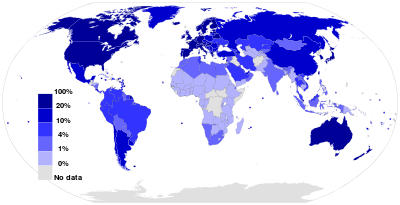Telecommunications in Burkina Faso include radio, television, fixed and mobile telephones, and the Internet.
Telecommunications in Guinea-Bissau include radio, television, fixed and mobile telephones, and the Internet.
Telecommunication in Honduras started in 1876 when the first telegraph was introduced, continued development with the telephone in 1891, radio in 1928, television in 1959, the Internet in the early 1990s, and cellphones in 1996.
The International Telecommunication Union Telecommunication Standardization Sector (ITU-T) is one of the three Sectors (branches) of the International Telecommunication Union (ITU). It is responsible for coordinating standards for telecommunications and Information Communication Technology, such as X.509 for cybersecurity, Y.3172 and Y.3173 for machine learning, and H.264/MPEG-4 AVC for video compression, between its Member States, Private Sector Members, and Academia Members.

The International Telecommunication Union (ITU) is a specialized agency of the United Nations responsible for many matters related to information and communication technologies. It was established on 17 May 1865 as the International Telegraph Union, significantly predating the UN and making it the oldest UN agency. Doreen Bogdan-Martin is the Secretary-General of ITU, the first woman to serve as its head.
Telecommunications in Lesotho include radio, television, print and online newspapers, fixed and mobile telephones, and the Internet.
Telecommunications in Mozambique include radio, television, fixed and mobile telephones, and the Internet.
Nigeria is Africa's largest ICT market, accounting for 82% of the continent's telecoms subscribers and 29% of internet usage. Globally, Nigeria ranks 11th in the absolute number of internet users and 7th in the absolute number of mobile phones.
Telecommunications in Sudan includes fixed and mobile telephones, the Internet, radio, and television. Approximately 12 million out of 45 million people in Sudan use the Internet, mainly on smartphones and mobile computers.
Telecommunications in Suriname includes radio, television, fixed and mobile telephones, and the Internet.
Telecommunications in Albania include radio, television, fixed and mobile telephones, and the Internet.

Internet access is a facility or service that provides connectivity for a computer, a computer network, or other network device to the Internet, and for individuals or organizations to access or use applications such as email and the World Wide Web. Internet access is offered for sale by an international hierarchy of Internet service providers (ISPs) using various networking technologies. At the retail level, many organizations, including municipal entities, also provide cost-free access to the general public. Types of connections range from fixed-line cable to mobile and satellite.
The global digital divide describes global disparities, primarily between developed and developing countries, in regards to access to computing and information resources such as the Internet and the opportunities derived from such access.

Information and communications technology (ICT) is an extensional term for information technology (IT) that stresses the role of unified communications and the integration of telecommunications and computers, as well as necessary enterprise software, middleware, storage and audiovisual, that enable users to access, store, transmit, understand and manipulate information.

Mobile broadband is the marketing term for wireless Internet access via mobile (cell) networks. Access to the network can be made through a portable modem, wireless modem, or a tablet/smartphone or other mobile device. The first wireless Internet access became available in 1991 as part of the second generation (2G) of mobile phone technology. Higher speeds became available in 2001 and 2006 as part of the third (3G) and fourth (4G) generations. In 2011, 90% of the world's population lived in areas with 2G coverage, while 45% lived in areas with 2G and 3G coverage. Mobile broadband uses the spectrum of 225 MHz to 3700 MHz.
The Internet in Botswana is used by approximately 87.2% of the population, as of 2023. There has been a massive increase in internet users since 2013 when only 30% of the population of Botswana was found to use the internet. This is notably higher than the percentage of internet users in Africa as a whole, which is around 43%. For reference, in 2023, the global statistic for internet users is 66%.
The Internet in Bangladesh has witnessed significant growth despite facing many constraints in expanding Internet access and use, development of the Internet and Information Technology are high government priorities. In March 2021, Internet users in Bangladesh increased to 116 million. On 19 February 2018, Bangladesh started the 4G network service.
The Broadband Commission for Sustainable Development was established in May 2010 as a joint initiative by the International Telecommunication Union (ITU) and the United Nations Educational, Scientific and Cultural Organization (UNESCO) to promote Internet access, in particular, broadband networks in order to help achieve United Nations development goals, such as the Millennium Development Goals. The Commission was renamed the Broadband Commission for Sustainable Development, following the adoption of the UN's Sustainable Development Goals in September 2015.

















